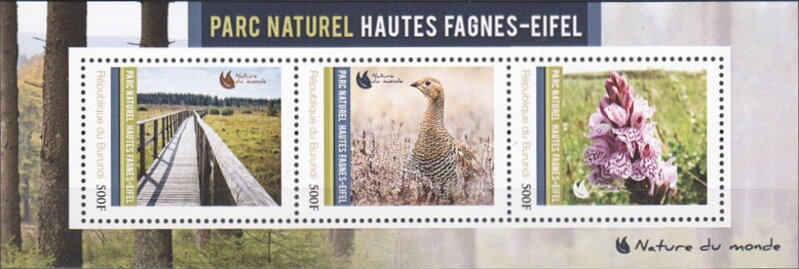Mini Sheet: Natural Parks - High Fens-Eifel (Burundi 2012)
Natural Parks - High Fens-Eifel (Burundi 2012)
01 January (Burundi ) within release Natural Parks (2012) goes into circulation Mini Sheet Natural Parks - High Fens-Eifel face value 3*500 Burundian franc
| Mini Sheet Natural Parks - High Fens-Eifel in catalogues | |
|---|---|
| Colnect codes: | Col: BI 2012-39 |
Mini Sheet is square format.
No year date inscribed on the counterfeit stamps. Illegal stamps produced in Eastern Europe and distributed by Eastern European counterfeit stamp dealers. Dating on many based on year they first appeared which in this case is 2012. BEWARE of criminal sellers offering them as "issued" in different years other than this. Avoid anyone selling these! From "Natural Parks" series.Also in the issue Natural Parks (2012):
- Mini Sheet - Natural Parks - Burdinale and Mehaigne Valley face value 3*500;
- Mini Sheet - Natural Parks - Burdinale and Mehaigne Valley face value 6*500;
- Mini Sheet - Natural Parks - High Country face value 6*500;
- Mini Sheet - Natural Parks - High Country face value 3*500;
- Mini Sheet - Natural Parks - High Fens-Eifel face value 6*500;
- Mini Sheet - Natural Parks - High Fens-Eifel face value 3*500;
- Mini Sheet - Natural Parks - Hill Country face value 6*500;
- Mini Sheet - Natural Parks - Hill Country face value 3*500;
- Mini Sheet - Natural Parks - Scheldt Plains face value 6*500;
- Mini Sheet - Natural Parks - Scheldt Plains face value 3*500;
- Mini Sheet - Natural Parks - Two Ourthes face value 6*500;
- Mini Sheet - Natural Parks - Two Ourthes face value 3*500;
- Mini Sheet - Natural Parks - Upper Sure Anlier Forest face value 6*500;
- Mini Sheet - Natural Parks - Upper Sure Anlier Forest face value 3*500;
- Mini Sheet - Natural Parks - Viroin-Hermeton face value 6*500;
- Mini Sheet - Natural Parks - Viroin-Hermeton face value 3*500;
Mini Sheet Natural Parks - High Fens-Eifel it reflects the thematic directions:
Animals are multicellular, eukaryotic organisms of the kingdom Animalia (also called Metazoa). All animals are motile, meaning they can move spontaneously and independently, at some point in their lives. Their body plan eventually becomes fixed as they develop, although some undergo a process of metamorphosis later on in their lives. All animals are heterotrophs: they must ingest other organisms or their products for sustenance.
Birds (Aves), a subgroup of Reptiles, are the last living examples of Dinosaurs. They are a group of endothermic vertebrates, characterised by feathers, toothless beaked jaws, the laying of hard-shelled eggs, a high metabolic rate, a four-chambered heart, and a strong yet lightweight skeleton. Birds live worldwide and range in size from the 5 cm (2 in) bee hummingbird to the 2.75 m (9 ft) ostrich. They rank as the class of tetrapods with the most living species, at approximately ten thousand, with more than half of these being passerines, sometimes known as perching birds. Birds are the closest living relatives of crocodilians.
A bridge is a structure built to span physical obstacles without closing the way underneath such as a body of water, valley, or road, for the purpose of providing passage over the obstacle. There are many different designs that each serve a particular purpose and apply to different situations. Designs of bridges vary depending on the function of the bridge, the nature of the terrain where the bridge is constructed and anchored, the material used to make it, and the funds available to build it.
A flower, sometimes known as a bloom or blossom, is the reproductive structure found in plants that are floral (plants of the division Magnoliophyta, also called angiosperms). The biological function of a flower is to effect reproduction, usually by providing a mechanism for the union of sperm with eggs. Flowers may facilitate outcrossing (fusion of sperm and eggs from different individuals in a population) or allow selfing (fusion of sperm and egg from the same flower). Some flowers produce diaspores without fertilization (parthenocarpy). Flowers contain sporangia and are the site where gametophytes develop. Many flowers have evolved to be attractive to animals, so as to cause them to be vectors for the transfer of pollen. After fertilization, the ovary of the flower develops into fruit containing seeds. In addition to facilitating the reproduction of flowering plants, flowers have long been admired and used by humans to beautify their environment, and also as objects of romance, ritual, religion, medicine and as a source of food.
Flora is the plant life occurring in a particular region or time, generally the naturally occurring or indigenous—native plant life. The corresponding term for animal life is fauna. Flora, fauna and other forms of life such as fungi are collectively referred to as biota. Sometimes bacteria and fungi are also referred to as flora, as in the terms gut flora or skin flora.





